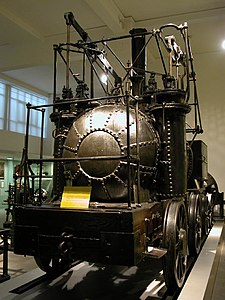| Revision as of 01:43, 2 July 2015 editDl2000 (talk | contribs)Autopatrolled, Extended confirmed users, New page reviewers, Pending changes reviewers, Rollbackers822,145 editsm en-GB← Previous edit | Revision as of 13:00, 11 August 2015 edit undoJackdude101 (talk | contribs)Extended confirmed users, Rollbackers, Template editors16,475 editsm Additional reference added.Next edit → | ||
| Line 2: | Line 2: | ||
| {{Use British English|date=July 2015}} | {{Use British English|date=July 2015}} | ||
| {{Other uses|Puffing Billy (disambiguation){{!}}Puffing Billy}} | {{Other uses|Puffing Billy (disambiguation){{!}}Puffing Billy}} | ||
| {{refimprove|date=June 2010}} | |||
| {{Infobox locomotive | {{Infobox locomotive | ||
| |name=''Puffing Billy'' | |name=''Puffing Billy'' | ||
| Line 33: | Line 32: | ||
| | volume=154 | | volume=154 | ||
| | issue=1,292 | | issue=1,292 | ||
| }}</ref> It was the first commercial ] steam locomotive, employed to haul ] ]s from the mine at ] to the docks at ] in ]. | }}</ref><ref></ref> It was the first commercial ] steam locomotive, employed to haul ] ]s from the mine at ] to the docks at ] in ]. | ||
| == History == | == History == | ||
Revision as of 13:00, 11 August 2015
For other uses, see Puffing Billy.
| Puffing Billy | |||||||||||||||||
|---|---|---|---|---|---|---|---|---|---|---|---|---|---|---|---|---|---|
 Puffing Billy as seen from the front Puffing Billy as seen from the front | |||||||||||||||||
| |||||||||||||||||
| |||||||||||||||||
| |||||||||||||||||
| |||||||||||||||||
Puffing Billy is an early railway steam locomotive, constructed in 1813-1814 by engineer William Hedley, enginewright Jonathan Forster and blacksmith Timothy Hackworth for Christopher Blackett, the owner of Wylam Colliery near Newcastle upon Tyne, in the United Kingdom. It is the world's oldest surviving steam locomotive. It was the first commercial adhesion steam locomotive, employed to haul coal chaldron wagons from the mine at Wylam to the docks at Lemington-on-Tyne in Northumberland.
History
Puffing Billy was one of the three similar engines built by Hedley, the resident engineer at Wylam Colliery, to replace the horses used as motive power on the tramway. In 1813 Hedley built for Blackett's colliery business on the Wylam Colliery line the prototypes, "Puffing Billy" and "Wylam Dilly". They were both rebuilt in 1815 with ten wheels, but were returned to their original condition in 1830 when the railway was relaid with stronger rails.
In the September 1814 edition of Annals of Philosophy two locomotives with rack wheels are mentioned (probably Salamanca and Blücher), then there is mention of "another steam locomotive at Newcastle, employed for a similar purpose , and moving along without any rack wheel, simply by its friction against the rail road". From the context this is at a different location to Blücher, so is probably Puffing Billy.
Puffing Billy remained in service until 1862, Edward Blackett, the owner of Wylam Colliery, lent it to the Patent Office Museum in South Kensington, London (later the Science Museum). He later sold it to the museum for £200. It is still on display there. Its sister locomotive, Wylam Dilly, is preserved in the Royal Museum in Edinburgh.
A replica has been built and was first run in 2006 at Beamish Museum. Another replica, built 1906 in a Royal Bavarian State Railways workshop, can be found in the German Museum, Munich.
Design
Puffing Billy incorporated a number of novel features, patented by Hedley, which were to prove important to the development of locomotives. It had two vertical cylinders on either side of the boiler, and partly enclosed by it, and drove a single crankshaft beneath the frames, from which gears drove and also coupled the wheels allowing better traction.



The engine had a number of serious technical limitations. Running on cast iron Wagonway plates, its eight-ton weight was too heavy and broke them, encouraging opponents of locomotive traction to criticise the innovation. This problem was alleviated by redesigning the engine with four axles so that the weight was spread more evenly. The engine was eventually rebuilt as a four-wheeler when improved edge rails track was introduced around 1830. It was not particularly fast, being capable of no more than 5 mph (8 km/h).
Legacy
Puffing Billy was an important influence on George Stephenson, who lived locally, and its success was a key factor in promoting the use of steam locomotives by other collieries in north-eastern England.
It also entered the language as a metaphor for an energetic traveller, and phrases like "puffing like Billy-o" and "running like Billy-o" are thought to derive from the locomotive's name.
References
- "Puffing Billy becomes world's oldest surviving locomotive". the Railway Magazine. 154 (1, 292): 9. December 2008.
- Steamlocomotive.com - Science Museum
- Casserley, H.C. (1976). Preserved locomotives (4th ed.). London: Ian Allan. pp. 13–4. ISBN 071100725X.
- Thomson, Thomas, ed. (1814), Annals of Philosophy, vol. IV, Robert Baldwin, p. 232, retrieved 16 December 2014
- Science Museum (1958). The British railway locomotive 1803-1850. London: Science Museum. p. 11.
Further reading
- Kirtley, Allan, Longbottom, Patricia, Blackett, Martin. A History of the Blacketts. (2013) The Blacketts. ISBN 978-0-9575675-0-4.
{{cite book}}: CS1 maint: multiple names: authors list (link)
| Pre-1830 steam locomotives | |
|---|---|
| Road |
|
| Railway |
|
| Designers | |